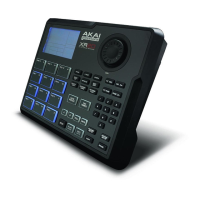36
EDITING PATTERNS – TRANSPOSITION
Each Pattern on the XR20 has a Pattern Transposition setting (0 by default). This setting allows
you to quickly transpose the selected Pattern’s Synth content. The Pattern Transposition setting
will be stored along with all other Pattern parameters once the Pattern is saved into memory (See
“Editing Patterns – Save/Copy Functions” section for information on saving Pattern data).
To change Pattern Transposition:
1. The XR20 should be in Pattern mode.
2. Press and hold SYNTH.
3. While holding down SYNTH, press the PAGE
RIGHT button.
4. The screen will display PATTRANS on the top line,
along with the current transposition setting on the
bottom line.
5. Use the DATA dial or INC / DEC buttons to select
the transposition in semitones (-12 to +12
semitone range).
Please note: Pattern Transposition affects all sub-patterns contained in the selected Pattern.
Please note: Pattern data needs to be saved to memory for the Pattern Transposition setting to be
recalled the next time you load the Pattern.
PATTERN STEP EDITING (STEP EDIT MODE)
Step editing is an approach of entering notes and other values for a Pattern in a non-realtime
method.
Step mode provides detailed Pattern editing. (Note that "step" does not refer to Song steps, but to
the steps in a Pattern that hold drum events.) You can move through a Pattern one step at a time,
stop at each event as desired, and delete the event, add an event, or change an event's volume.
While occasionally somewhat tedious, Step Edit mode allows editing drum parts to your exact
specifications.
Each step (also called a sub-beat) is 1/96th of a beat in duration, so at maximum resolution it
takes 96 steps to "move through" a quarter note. To save time, you can step through the Pattern
at various note values, as set by the quantization value (which is why it's preferable to select the
quantization rate at which the Pattern was recorded). Example: A 16th note consists of 24 sub
beats, so setting the quantization value to 1/16 lets you step through the Pattern 24 sub-beats at
a time. The following chart relates the number of sub-beats to note/quantization values.
NOTE VALUE NOTE NAME SUB-BEATS
1/4 QUARTER NOTE 96
1/6 QUARTER NOTE TRIPLET 64
1/8 EIGHTH NOTE 48
1/12 EIGHTH NOTE TRIPLET 32
1/16 16th NOTE 24
1/24 16th NOTE TRIPLET 16
1/32 32nd NOTE 12
1/48 32nd NOTE TRIPLET 8

